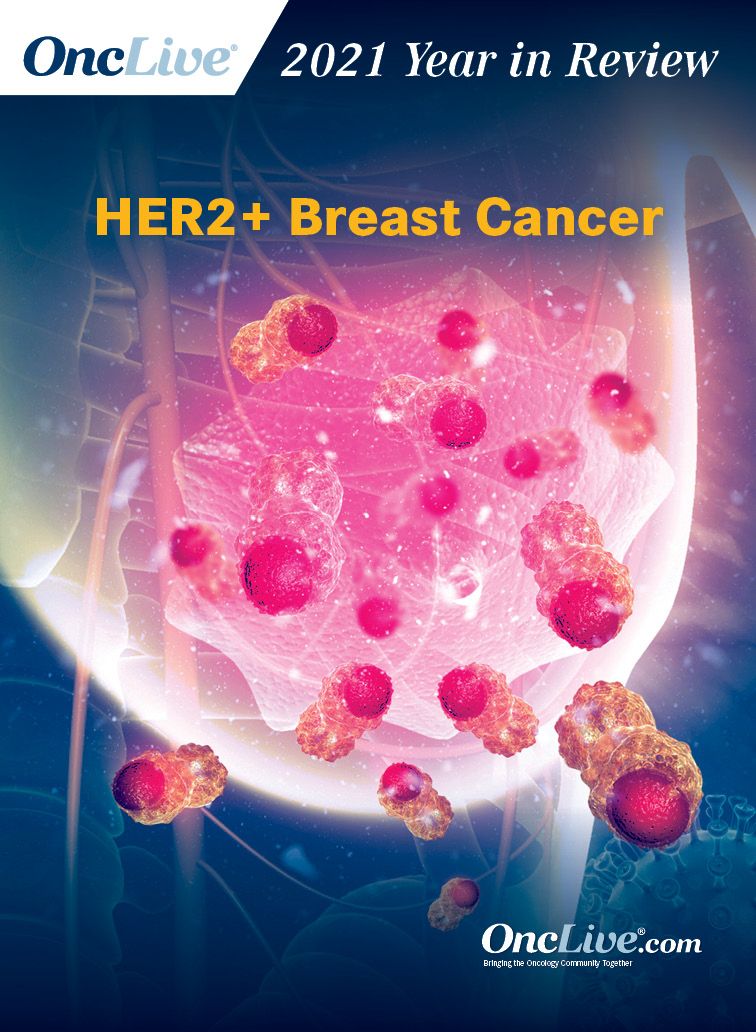Publication
Article
Supplements and Featured Publications
Trastuzumab Deruxtecan Leaves Lasting Impact on Treatment Sequencing in HER2+ Metastatic Breast Cancer
Author(s):
Sara A. Hurvitz, MD, reflects on the past year in HER2-positive breast cancer.
Sara A. Hurvitz, MD

As data continue to unfold with antibody-drug conjugates (ADCs) and tyrosine kinase inhibitors in HER2positive breast cancer in earlier and curative settings, it will be particularly important to pay attention to treatment sequencing recommendations made by the National Comprehensive Cancer Network (NCCN) guidelines, explained Sara A. Hurvitz, MD.
“The NCCN is set up to pivot more quickly than the regulatory agencies are when new data emerge. It’s not uncommon for us to see the NCCN or even ESMO [European Society for Medical Oncology] or [American Society of Clinical Oncology] guidelines quickly change—within weeks—in response to major data that come out at a conference, whereas it may take the regulatory agencies months to assess and react to those data,” said Hurvitz.
In an interview with OncLive®, Hurvitz reflected on the past year in HER2-positive breast cancer. She is an associate professor in the David Geffen School of Medicine of the University of California, Los Angeles (UCLA); medical oncologist and medical director, Jonsson Comprehensive Cancer Center Clinical Research Unit; co-director, Santa Monica-UCLA Outpatient Oncology Practices; and director, Breast Cancer Clinical Trials Program, UCLA.
OncLive®: What advances stand out regarding HER2-positive breast cancer management when you look back on 2021?
Hurvitz: The biggest data that came out in 2021 relating to HER2-positive breast cancer were [those from] DESTINYBreast03 [NCT03529110]. The interim analysis [data] presented at the 2021 ESMO Congress, which showed a significantly improved progression-free survival [PFS] with fam-trastuzumab deruxtecan-nxki [Enhertu] compared with ado-trastuzumab emtansine [T-DM1; Kadcyla], were almost immediately practice changing.
We also saw results from the TULIP trial [NCT03262935] at the 2021 ESMO Congress, looking at vic-trastuzumab duocarmazine [SYD985]. TULIP was a phase 3 clinical trial comparing trastuzumab duocarmazine with treatment of physician’s choice. The primary end point for this drug was met, with an improvement in median PFS. However, the toxicity profile—[specifically,] ocular toxicities—is something that needs to be explored a bit further. This drug is not yet FDA approved, so I wouldn’t say that these data are practice changing yet. We’ll need to see more information about management of ocular toxicities and just how serious they are before clinically seeing this drug come to fruition.
What trials will be important to keep an eye on in 2022 in HER2-positive disease?
[In 2021,] we [saw] [follow-up] data [with] ADCs and new phase 1 data [with] other ADCs in HER2positive breast cancer. It has been an exciting year but clearly, a lot more data are forthcoming in the next year or two.
I’m not sure [exactly] when HER2-positive trials are going to read out, but several studies are ongoing in the curative setting, looking at, for example, the use of tucatinib [Tukysa] in the curative setting; T-DXd in the frontline setting of metastatic breast cancer; and more data regarding [central nervous system] metastases and the use of ADCs there. A lot of these trials will be interesting to follow. It will also be interesting to see how T-DXd fares in the HER2-low population. Those results may be available in the next year or two.
What questions regarding treatment sequencing in HER2-positive breast cancer were answered in 2021, and what do you anticipate the focus of research will be in 2022?
In 2021, data came out from DESTINY-Breast03 indicating that trastuzumab deruxtecan should be the standard secondline therapy after taxane and trastuzumab [Herceptin], so that has moved T-DM1 to a later-line setting. What we don’t know is how well T-DM1 works after trastuzumab deruxtecan. We also are waiting to see results from trials that will look at combinations of tucatinib with ADCs, such as trastuzumab deruxtecan and TDM-1. Understanding how these sorts of combinations work will potentially change the sequencing in the coming years depending on what those results are.
How have the updated NCCN guidelines influenced your practice for patients with HER2-positive breast cancer?
The NCCN guidelines are important in guiding clinicians regarding best available evidence to support our treatment decisions. It’s very helpful to have guidelines that are based upon level 1 evidence and provide guidance on how to apply level 2 evidence, for example. When new data emerge, the NCCN is set up to pivot more quickly than perhaps the regulatory agencies are.
What other factors influence your treatment recommendations in the metastatic setting?
Not only clinical trial data, FDA approval status, and NCCN guidelines are important in making treatment recommendations; the patient’s own take on the situation, their own life goals, and their own symptoms and comorbidities [also are important]. All these things weigh in as we make treatment recommendations and decisions with our patients. For a given patient who has several comorbidities and concomitant medications, the treatment recommendation may be quite different from the one given to a patient who is contending only with advanced breast cancer. We have to look at the whole person and not just what the data state from a clinical trial.
Is there a role in treatment sequencing for all recently approved agents?
We currently have 8 HER2-targeted therapies available for metastatic HER2-positive breast cancer. We are fairly certain that we should use a taxane, trastuzumab, and pertuzumab [Perjeta] in the frontline setting. We’re [also currently] fairly certain that trastuzumab deruxtecan is the right agent in the second-line setting, but after that we don’t have much in the way of clinical trial data to tell us how to best sequence all the other agents available to us in the third-line setting and beyond.
It’s important for us to look at patients’ disease characteristics, location of disease, presence or absence of brain metastases, comorbidities, and toxicity profiles when making a decision or recommendation regarding how to sequence treatment, because we don’t have clinical trials that say sequencing A followed by B followed by C is better than C followed by B followed by A.
We do have great evidence supporting the use of tucatinib-based therapy for those with brain metastases in the second-line setting and beyond, which is where that agent is FDA approved. We also have good evidence supporting trastuzumab deruxtecan in the third-line setting and beyond for patients who haven’t yet received it, but we are awaiting clinical trials to help gauge the relative benefits of one of these agents vs the other. It will be interesting to see whether novel combinations of these therapies are going to be supported by ongoing trials, or whether we’ll have more information regarding how to properly sequence them.










